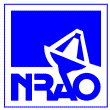
National Radio Astronomy Observatory
P.O. Box O
Socorro, NM 87801
http://www.nrao.edu
December 7, 2007
Contacts:
Dave Finley, NRAO
(575) 835-7302
dfinley@nrao.edu
Norbert Junkes (MPIfR)
+49 228 525 399
njunkes@mpifr-bonn.mpg.de
Two of the world's leading astronomical institutions have formalized an agreement to cooperate on joint efforts for the technical and scientific advancement of radio astronomy. The National Radio Astronomy Observatory (NRAO) in the United States and the Max-Planck Institute for Radioastronomy (MPIfR) in Germany concluded a Memorandum of Understanding outlining planned collaborative efforts to enhance the capabilities of each other's telescopes and to expand their cooperation in scientific research.
In the first project pursued under this agreement, the MPIfR will contribute $299,000 to upgrade the continent-wide Very Long Baseline Array's (VLBA) capability to receive radio emissions at a frequency of 22 GHz. This improvement will enhance the VLBA's scientific productivity and will be particularly important for cutting-edge research in cosmology and enigmatic cosmic objects such as gamma-ray blazars.
"This agreement follows many years of cooperation between our institutions and recognizes the importance of international collaboration for the future of astronomical research," said Fred K.Y. Lo, NRAO Director.
"Our two institutions have many common research goals, and joining forces to keep all our telescopes at the forefront of technology will be highly beneficial for the science," said Anton Zensus, Director at MPIfR.
In addition to the VLBA, the NRAO operates the Very Large Array (VLA) in New Mexico and the Robert C. Byrd Green Bank Telescope (GBT) in West Virginia. The MPIfR operates the 100-meter Effelsberg Radio Telescope in Germany and the 12-meter APEX submillimeter telescope in 5100 m altitude in the Cilean Atacama desert (together with the European Southern Observatory and the Swedish Onsala Space Observatory). With the 100-meter telescope, it is part of the VLBA network in providing transatlantic baselines. Both institutions are members of a global network of telescopes (the Global VLBI Network) that uses simultaneous observations to produce extremely high-resolution images, and another network (the High Sensitivity Array) that uses the same technique with large telescopes to observe particularly faint celestial objects. With this technique, NRAO telescopes work with MPIfR's Effelsberg telescope to produce images hundreds of times more detailed than those from the Hubble Space Telescope.
Both institutions also are part of the international collaboration building the Atacama Large Millimeter/submillimeter Array (ALMA) in Chile and of the international planning effort to build a Square Kilometer Array.
The VLBA is a system of ten antennas, each with a dish 25 meters in diameter. From Mauna Kea on the Big Island of Hawaii to St. Croix in the U.S. Virgin Islands, the VLBA spans more than 8000 kilometers.
Under the new agreement, the two institutions will continue their previous observational collaborations, and in addition will share resources to improve the technical capabilities of each other's telescopes, particularly at short wavelengths, They also will collaborate in the peer-reviewed process each uses to allocate observing time, and agree to mutually maintain an "open skies" policy allowing open access to each other's telescopes on a peer-reviewed basis.
The agreement notes the report of the U.S. National Science Foundation's (NSF) Senior Review committee, which called upon the NRAO to seek partners to contribute to the operation of the VLBA. The MPIfR affirms its strong interest in maintaining the VLBA's unique scientific capabilities, and its monetary contribution toward the 22 GHz upgrade of the VLBA is a solid sign of that commitment.
"The VLBA provides the greatest resolving power of any instrument in astronomy, and the MPIfR's contribution to enhancing its capabilities is an important validation of the VLBA's importance to frontier astrophysics," Lo said.
The joint VLBA project calls for the MPIfR to fund the receiving-system upgrades and the NRAO to perform the work. The project is scheduled to be complete, with all 10 VLBA antennas upgraded, in August of 2008.
The upgrade will make the VLBA's receiving system for 22 GHz 30 percent more sensitive. This will enhance the VLBA's capability to advance a key area of science using rotating disks of water molecules at the cores of distant galaxies to make precise measurements of the distances to those galaxies. This technique, first used in the late 1990s, can measure large cosmic distances directly, without relying on various assumptions required for more indirect techniques. The improved precision is important to resolving a number of frontier astrophysical problems, including the nature of the mysterious "dark energy" that appears to be accelerating the expansion of the Universe. This research project involves scientists from both MPIfR and NRAO, and, in addition to the VLBA, the Effelsberg telescope, the GBT and the VLA.
The National Radio Astronomy Observatory is a facility of the National Science Foundation, operated under cooperative agreement by Associated Universities, Inc. The Max Planck Institute for Radio Astronomy is one of about 80 research institutes of the Max Planck Society for the Promotion of Research in Germany.